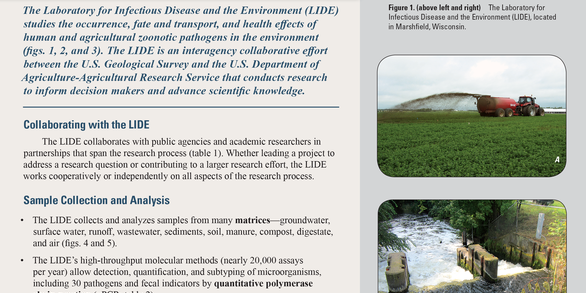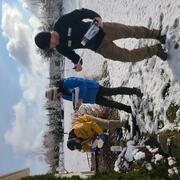Laboratory for Infectious Disease and the Environment
News
New publication on study on antibiotic resistance in well water
New publication on study on antibiotic resistance in well water
Launch of Northeast Wisconsin Well Water Advisory Forecast Study
Launch of Northeast Wisconsin Well Water Advisory Forecast Study
Publications
Two risk assessments: Evaluating the use of indicator HF183 Bacteroides versus pathogen measurements for modelling recreational illness risks in an urban watershed
The purpose of this study was to evaluate the performance of HF183 Bacteroides for estimating pathogen exposures during recreational water activities. We compared the use of Bacteroides-based exposure assessment to exposure assessment that relied on pathogen measurements. We considered two types of recreational water sites: those impacted by combined sewer overflows (CSOs) and those not impacted b
A multi-marker assessment of sewage contamination in streams using human-associated indicator bacteria, human-specific viruses, and pharmaceuticals
Human sewage contaminates waterways, delivering excess nutrients, pathogens, chemicals, and other toxic contaminants. Contaminants and various sewage indicators are measured to monitor and assess water quality, but these analytes vary in their representation of sewage contamination and the inferences about water quality they support. We measured the occurrence and concentration of multiple microbi
Quantitative microbial risk assessment for ingestion of antibiotic resistance genes from private wells contaminated by human and livestock fecal sources
We used quantitative microbial risk assessment to estimate ingestion risk for intI1, erm(B), sul1, tet(A), tet(W), and tet(X) in private wells contaminated by human and/or livestock feces. Genes were quantified with five human-specific and six bovine-specific microbial source-tracking (MST) markers in 138 well-water samples from a rural Wisconsin county. Daily ingestion risk (probability of swallo
Science
Assessing the health risk from waterborne pathogens for public users recreating on future Iowa Water Trails recreation sites near Des Moines
Scientists at LIDE are collaborating with Polk County Conservation in central Iowa to estimate the health risk posed to recreators in the Des Moines River and tributaries. Samples collected over two years are tested for viral, bacterial, and protozoan pathogens, and health risk is estimated using quantitative microbial risk assessment (QMRA). Health risk will also be compared to microbial source...
Well Water Advisory Forecasts for northeast Wisconsin
The fractured bedrock of northeast Wisconsin is vulnerable to groundwater contamination because water and contaminants can move quickly. LIDE is launching a study to predict contamination of private wells in northeast WI using Runoff Risk Advisory Forecasts (RRAF). RRAF is an online tool that forecasts conditions conducive to surface runoff, and the long-term vision is to leverage its forecasts to...
Southwest Wisconsin Groundwater and Geology (SWIGG) study
The fractured bedrock aquifers of southwest Wisconsin are often overlain by shallow soils, so private wells are potentially vulnerable to contamination by nitrate and pathogens from the land surface. The goal of this study is to evaluate the extent and causes of private well water contamination in three southwest Wisconsin counties.






